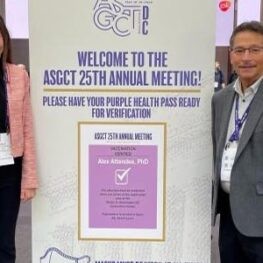UCLA Researchers Develop Base Editing Approach for Rare Genetic Immune Disorder
May 18, 2022
UCLA researchers said that they have shown the use of base editing could be used as a one-and-done approach to restore production of T cells in patients with the rare, genetic immune condition CD3 delta severe combined immune deficiency, also known as CD3 delta SCID.

Photo: Grace McAuley and Donald Kohn at the ASGCT Annual Meeting 2022
In an oral presentation at the American Society of Gene & Cell Therapy’s 2022 Annual Meeting on May 17, Grace McAuley from the UCLA lab of Donald Kohn shared the results of preclinical studies that found that base editing can correct the mutation that causes CD3 delta SCID and enable the production of functional T cells.
CD3 delta SCID is caused by a mutation in the CD3 delta gene, which produces a protein critical to the formation of T cells. CD3 delta SCID is caused by the same mutation to a single base in all patients and accounts for less than 1 percent of SCID cases worldwide.
Babies born with CD3 delta SCID are unable to produce these white blood cells that fight against pathogens in the body. Without T cells, patients are unable to fight infections. If untreated, they often die within the first two years of life. Bone marrow transplantation can be curative, but it is often difficult to locate a healthy matched bone marrow donor and recovery from the transplant can bring complications.
“We had never tried base editing in the lab before, so we weren’t sure how well it was going to work in blood stem cells,” said Kohn, a member of the Eli and Edythe Broad Center of Regenerative Medicine and Stem Cell Research at UCLA. “Grace studied the known genetic mutation that causes CD3 delta SCID and recognized that it is an ideal target for this new approach.”
Base editing is based on the gene editing platform CRISPR-Cas9, and both techniques can be used to accomplish the same goal: changing a single base, one of the letters in the base pair that makes up a rung on the DNA ladder. However, CRISPR-Cas9 cuts both strands of DNA when making this change, while base editing cuts just one strand.
“Because base editing only nicks one strand of DNA, it has the potential to be more precise and efficient than other gene editing approaches,” said Kohn, who is also a distinguished professor of microbiology, immunology and molecular genetics in the UCLA College and of pediatrics and molecular and medical pharmacology at the David Geffen School of Medicine at UCLA. “However, this also makes its application more limited: a base editor can only be designed to target a single base and many genetic conditions are caused by mutations to different bases within the same gene.”
The researchers hope to bring this therapy to a phase 1 clinical trial. If this project proves successful, the team projects similar base editing approaches could be applied to a range of inherited blood cell conditions, such as sickle cell disease and other primary immune deficiencies.
Author: Rare Daily Staff

Stay Connected
Sign up for updates straight to your inbox.
